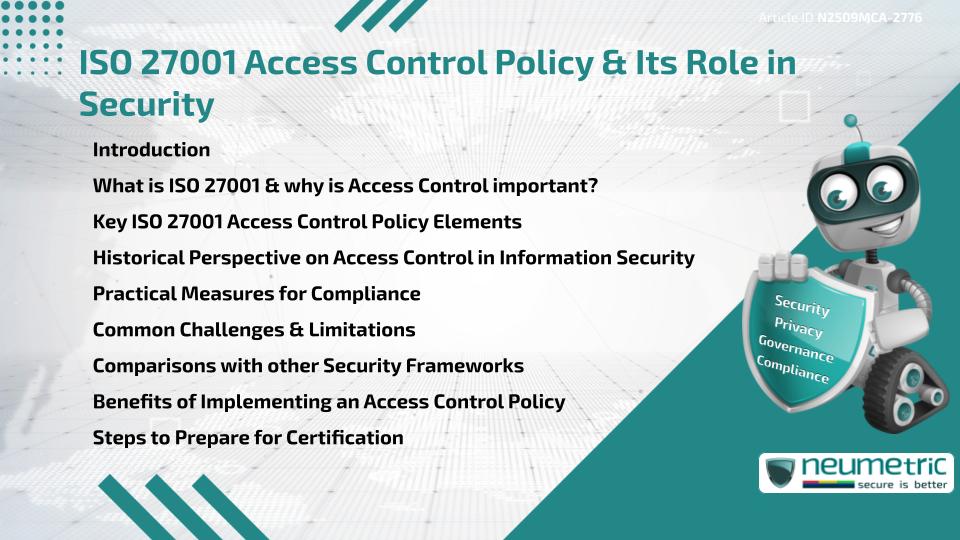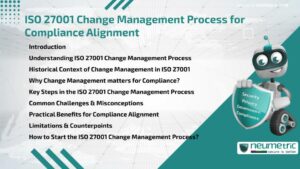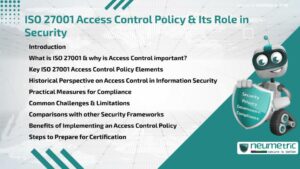Table of Contents
ToggleIntroduction
ISO 27001 Access Control Policy is a cornerstone of Certification & Information Security Management. It defines how Organisations manage who has access to systems, data & resources, ensuring that only authorised individuals can perform specific actions. Access Control Policies protect Sensitive Information, reduce Risks of misuse & strengthen overall Security Posture. This article explains the purpose, elements, benefits & challenges of implementing an Access Control Policy under ISO 27001.
What is ISO 27001 & why is Access Control important?
ISO 27001 is the international Standard for managing Information Security through an Information Security Management System [ISMS]. Access Control is central to ISO 27001 because unauthorised use of systems or data can cause Breaches, Financial losses & Reputational harm. An effective Access Control Policy ensures that Employees & Third parties only access what they need to perform their roles.
Key ISO 27001 Access Control Policy Elements
The Standard outlines several Access Control measures, including:
- User registration & deregistration processes.
- Role-based Access Control aligned with job responsibilities.
- Use of strong Authentication methods, such as Multifactor Authentication.
- Regular Reviews of User Access Rights.
- Monitoring & Logging of access activities.
- Secure management of Privileged Accounts.
Together, these elements ensure that Sensitive Information is accessible only to the right people, at the right time, for the right purpose.
Historical Perspective on Access Control in Information Security
Access Control has always been part of Information Security. Early methods involved physical restrictions such as locked filing cabinets. With the rise of computer systems, Organisations developed Login Credentials & Passwords. Over time, more advanced methods like Biometrics & Multifactor Authentication evolved. ISO 27001 brought these practices together in a structured Policy Framework that integrates with both digital & physical controls.
Practical Measures for Compliance
Organisations preparing for Certification can take several practical steps:
- Define clear roles & responsibilities for Access management.
- Implement User provisioning systems for granting & revoking access.
- Enforce strong Password & Authentication Policies.
- Monitor Access Logs & Review them regularly.
- Train Employees on responsible use of access rights.
Documenting these measures & showing Evidence of enforcement is critical for Compliance.
Common Challenges & Limitations
Compliance with ISO 27001 Access Control Policy can be challenging due to factors such as:
- Complexity of managing access across multiple systems.
- Resistance from Employees to stricter access rules.
- Costs of implementing advanced technologies.
- Risks of human error in granting or revoking access.
These challenges require strong Governance, Automation where possible & regular Internal Audits.
Comparisons with other Security Frameworks
Frameworks such as NIST & SOC 2 also stress Access Control. However, ISO 27001 integrates Access Management within a broader ISMS, making it part of an organisation’s overall Governance structure. This integration provides a more systematic approach compared to frameworks with narrower scopes.
Benefits of Implementing an Access Control Policy
Organisations that comply with ISO 27001 Access Control Policy gain several benefits:
- Reduced Risk of unauthorised access & data breaches.
- Improved Accountability & Traceability of User actions.
- Stronger Compliance with Legal & Regulatory requirements.
- Increased Customer Confidence & Trust.
These benefits highlight why Access Control is a key focus area during certification.
Steps to Prepare for Certification
To prepare for ISO 27001 Certification, Organisations should:
- Review existing Access Control measures against the standard.
- Identify Gaps in policy & practice.
- Develop & implement a comprehensive Access Control Policy.
- Train staff on Access-related Procedures.
- Conduct Internal Audits before undergoing Certification Audits.
These steps create a strong foundation for successful Certification.
Takeaways
- Access Control is central to protecting Sensitive Information under ISO 27001.
- Policies must cover User registration, Authentication & Monitoring.
- Regular Reviews & Employee Training strengthen Compliance.
- Challenges include complexity, costs & human error.
- A robust policy builds Trust, Compliance & security Resilience.
FAQ
What is an ISO 27001 Access Control Policy?
It is a set of rules & processes that regulate who can access information Systems & Data within an Organisation.
Why is Access Control important in ISO 27001?
Because without clear access restrictions, Sensitive Information is vulnerable to misuse or theft.
Who should be responsible for managing Access Control?
Typically, the Information Security team or system administrators oversee access, with oversight from management.
What are examples of Access Control measures?
Examples include Role-based access, Multifactor Authentication & monitoring of Privileged Accounts.
How can Organisations demonstrate Compliance?
By documenting Policies, maintaining Access Logs & performing regular Audits.
What challenges do Organisations face in implementing Access Control?
Challenges include technical complexity, user resistance & the cost of advanced security tools.
What happens if Access Control is weak or ignored?
Weak Access Control can lead to Breaches, Regulatory Penalties & Certification failure.
Need help for Security, Privacy, Governance & VAPT?
Neumetric provides organisations the necessary help to achieve their Cybersecurity, Compliance, Governance, Privacy, Certifications & Pentesting needs.
Organisations & Businesses, specifically those which provide SaaS & AI Solutions in the Fintech, BFSI & other regulated sectors, usually need a Cybersecurity Partner for meeting & maintaining the ongoing Security & Privacy needs & requirements of their Enterprise Clients & Privacy conscious Customers.
SOC 2, ISO 27001, ISO 42001, NIST, HIPAA, HECVAT, EU GDPR are some of the Frameworks that are served by Fusion – a SaaS, multimodular, multitenant, centralised, automated, Cybersecurity & Compliance Management system.
Neumetric also provides Expert Services for technical security which covers VAPT for Web Applications, APIs, iOS & Android Mobile Apps, Security Testing for AWS & other Cloud Environments & Cloud Infrastructure & other similar scopes.
Reach out to us by Email or filling out the Contact Form…





